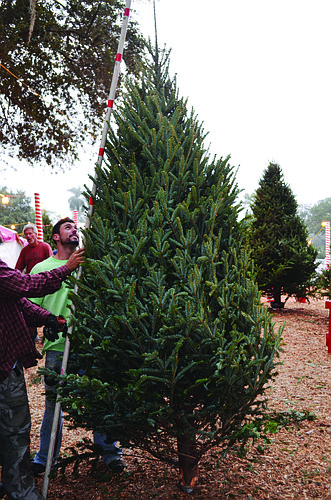- April 25, 2024
-
-
Loading

Loading

’Tis the season! Although your Christmas may not be white, that doesn’t mean it can’t be merry. Choosing a tree is the first step to turning your home into a winter wonderland, so make sure you check your list twice when it comes to choosing the perfect tree.
Some say the best kind of tree is big and full, while others say it must be fragrant and dark green. If you’re still stuck on which tree is right for you, here is our guide to the most popular Christmas trees in the U.S. — and where to fine them locally.
Fraser fir
Cost: A 6-foot Fraser fir comes in around $60 to $70.
Needles: Generally soft, yet strong
Many tree experts recommend the Fraser fir. This tree has a long life and stays fresh up to six weeks. A Fraser is the greenest of the trees; is the most fragrant; and loses fewer needles than other trees. Because their needles are thick and their branches strong, firs are good for families interested in loading the tree with keepsake ornaments.
Scotch pine
Cost: A 6-foot scotch pine will cost about $35 to $40.
Needles: Long, sharp and can drop quickly
The scotch pine is considered the classic, old-school Christmas tree. This tree’s needles don’t shed easily, even when they are dry — which occurs after six to seven weeks. This tree is the most economical. It’s bright green and is the most common Christmas tree in the U.S. due to its ability to remain fresh throughout the season.
Colorado blue spruce
Cost: A 6-foot Colorado blue spruce costs between $50 to $60. Needles: Less fragrant, rough and sharp
Although their needles are sharp, spruces carry a symmetrical form and have strong branches. The trees have a bluish-gray color and have little aroma. Spruces have the shortest lives of Christmas trees and are said to last only three weeks. Despite its short life, the main reason why people like the blue spruce is because of its typical Christmas-tree form.
Wild Card tree: White pine
A white pine has long, soft, feather-like needles. Although this tree makes a beautiful addition to your Christmas décor, it is not good for hanging ornaments. White pines are fairly inexpensive. They are a bluish-green color and don’t have a strong smell. If you like the lightness of the white pine but still want to decorate your tree, try using tinsel.
CARE TIPS:
To ensure your tree’s longevity, make sure it’s watered and not sitting in the sun.
Trees produce sap when they are cut, which can slow down the tree’s water consumption and make it dry. Putting your tree in warm water when you get home will help the tree’s sap melt away, allowing it to absorb water more quickly.
Where to go
Evie’s on Bee Ridge
4736 Bee Ridge Road
Hours: 10 a.m. to 10 p.m. every day
Tree types: Fraser firs
Hyde Park Street and North Tamiami Trail
Hours: 8 a.m. to 9 p.m. every day
Benefits: This lot has about 750 trees from Michigan, North Carolina and Washington.
Tree types: Buyers have a selection of 12 types of spruces, firs and pines, in all shapes and sizes.
Pranger Christmas Trees
Robarts Arena, 3000 Ringling Blvd.
Hours: 9 a.m. to 10p.m. every day
Benefits: Dick Pranger has been bringing trees to Sarasota from his farm in Michigan for 31 years. He and his family sell the trees together.
Tree types: Trees include a variety of spruces, firs and pines.
Sarasota High School
950 S. Tamiami Trail (to the north of the old high school)
Hours: 4 to 9 p.m. weekdays and 9 a.m. to 9 p.m. on weekends
Benefits: All profits benefit the school’s wrestling team and help pay for travel expenses and team gear.
Tree types: Fraser firs
Vamo United Methodist Church
8521 Vamo Road
Hours: 1 to 8 p.m. Monday through Friday; 9 a.m. to 8 p.m. Saturday. Open until Monday, Dec. 16.
Benefits: All proceeds benefit the church’s food pantry fund as well as its monthly community meals, which help feed those less fortunate.
Tree types: Fraser firs
Contact Harriet Sokmensuer at [email protected]